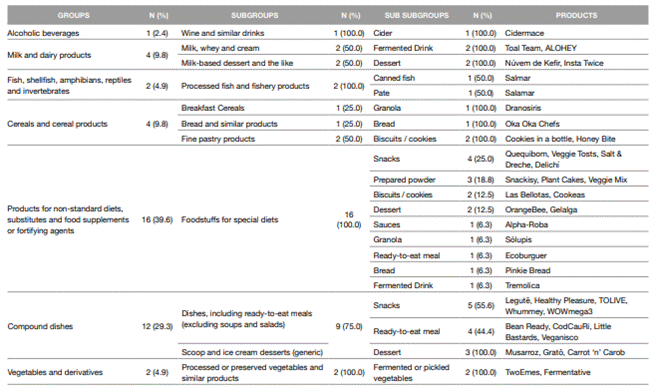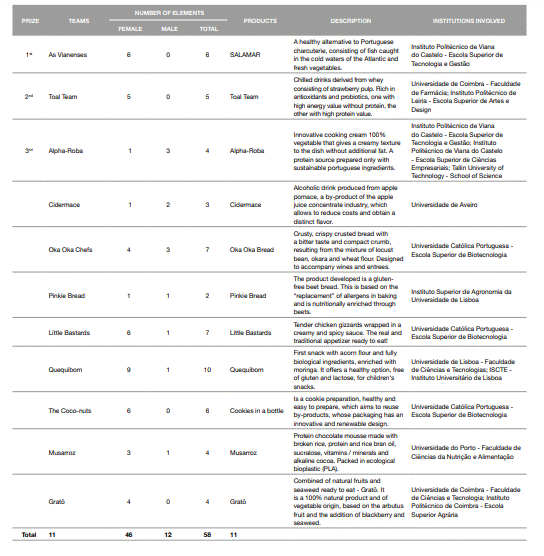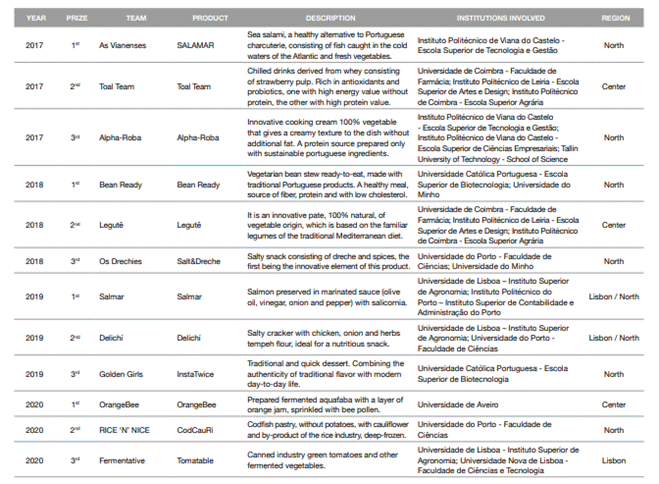INTRODUCTION
The agrifood sector stands out for its regional and continental cultural diversity, providing an ideal structure to stimulate creativity and innovation. This sector benefits from an ecosystem made up of stakeholders, academic and research institutions, which have a proven ability to carry out innovative Research and Development activities (1).
In the agrifood sector there are several opportunities and sources of innovation (2). Whenever customer demand changes, there is an opportunity to innovate in response to that demand, such as greater awareness of the circular economy (3). On the other hand, changes in the offer (emergence of new ingredients, enzymes, bioactive compounds), can also promote innovation and add value to products (4). Other potential drivers of entrepreneurial opportunities are, for example, the emergence of new information and communication technologies, such as mobile applications for delivering meals to the home (5) or to reduce food waste (6). Another opportunity may arise through legal and regulatory changes such as the European Union's initiative to ban single-use plastics (7), which even led to the creation of edible utensils.
The valorization of knowledge produced in research centers has been a great challenge for universities in contemporary societies. This situation led the institutions to develop a new objective within the scope of their activities, the facilitation of technology transfer and the promotion of academic entrepreneurship (8). Overcoming difficulties in the development of academic entrepreneurship and the consequent valorization of knowledge produced in universities are part of the objectives of bridging the gap between research and innovation in Europe (9).
Among the various ways to promote academic entrepreneurship are competitions or competitions linked to the agri-food sector to enable higher education students to provide new solutions to pressing issues in the food industry, such as the Ecothophelia Portugal Competition. According to the Ecotrophelia Portugal Competition Regulation (10), this aims to promote innovation, competitiveness and academic entrepreneurship in the agrifood sector. The Ecotrophelia Portugal Prize is promoted by PortugalFoods that is an association established in 2008 by companies, entities of the national scientific and technological system and regional and national entities that represent the various subsectors which compose the Portuguese agri- food sector. During this competition, the Portuguese representative in the European competition, Ecotrophelia Europe, is selected. Participation in this competition is based on the development of a food product, which could be an eco-innovative and sustainable food or drink. Only teams of students consisting of a minimum of 2 and a maximum of 6 students, aged 35 or under, enrolled in a Portuguese higher education institution, can participate. The National Jury is made up of representatives of the agri-food sector, as well as specialists in food innovation, who are selected for their notoriety, independence, and skills. These select the winners and award the prizes - ECOTROPHELIA Portugal Gold (2000 €), Silver (1000 €) and Bronze (500 €) (10).
OBJECTIVES
The present study aims to describe the finalist teams, as well as the characteristics of the products in the competition, in the editions of the Ecotrophelia Portugal Competition between 2017 and 2020, as sources of innovation for the food sector.
METHODOLOGY
A content analysis approach was adopted. This is a technique used to determine the presence of certain words or concepts in texts or sets of texts that can come from various sources (book chapters, interviews, newspaper articles, advertising, informal conversation, or any occurrence of communicative language). Then, the text is divided into categories and encoded. The encoded content can then be analyzed quantitatively for trends, patterns, relationships, similarities, differences, etc., and researchers can obtain information and make inferences about the messages within the texts (11).
A qualitative content analysis process was used (12). According to this author, content analysis begins with planning, moves to a stage of data collection, data analysis, and ends with a report and presentation of results. It also highlights that the data analysis is performed in 4 stages: 1. decontextualization, in which the units of meaning are identified; 2. recontextualization, which includes “content” and excludes “impurities”; 3. categorization, where homogeneous groups are identified; 4. compilation, in which conclusions are drawn.
The analyzed contents were collected through the official website of Ecotrophelia Portugal (10). Information from the 41 finalist teams in the competition between 2017 and 2020 was analyzed. The products in the contest were categorized according to the FoodEx2 classification and description system (13) on two levels (group and subgroup). Subsequently, a third level (subgroup) was added to better characterize the products, through content analysis. This was also used to categorize the characteristics claimed by the teams to describe the products.
For the analysis of the results, descriptive statistics were used, using frequency tables to systematize the results, using Microsoft Office Excel 365® software for the Microsoft Windows 10® operating system.
RESULTS
The same information could not be found for all participants in the competition. In this way, different results are presented for each edition of the competition and results are compared between teams / products for which complete information was obtained. Table 1 shows the 11 teams and 11 finalist products, including the 3 winners of the Ecotrophelia Portugal 2017 Competition. Eleven teams competed that presented 11 innovative products, most of the team members were female. The institutions that had the most students in this 2017 edition were the Instituto Politécnico de Viana do Castelo (Escola Superior de Tecnologia e Gestão) and Universidade Católica Portuguesa (Escola Superior de Biotecnologia). The participation of a foreign institution (Tallinn University of Technology - School of Science) stands out for the inclusion of an Erasmus student in the team. Table 2 shows the 12 winners of the Ecotrophelia Portugal Competition between the years 2017 and 2020. The institutions that had the most students to finalists in the 2017-2020 editions were the Instituto Politécnico de Viana do Castelo (Escola Superior de Ciências Empresariais; and Escola Superior de Tecnologia e Gestão), Universidade de Lisboa (Instituto Superior de Agronomia) and Universidade do Porto (Faculdade de Ciências). The North region was the one that contributed the most to the editions of the Ecotrophelia Portugal Competition (2017-2020). The institutions that contributed most to finalist students were the Universidade do Porto (26.2%), Universidade Católica Portuguesa
- Porto (16.4%), Instituto Politécnico de Coimbra (13.1%) and Universidade de Lisboa (8.2 %).
Of a total of 61 higher education institutions (Universities, Faculties, Polytechnic Institutes, etc.) from which the finalist students from the competition came, 57.4% belonged to the North region, 27.9% to the Center region, 13.1 % to the Lisbon Metropolitan Area, and 1.6% to the Alentejo region.
Table 3 shows the results of the categorization, with three levels, of the 41 final products of the Ecotrophelia Competition (2017-2020). The most frequent groups (subgroups) were: products for non-standard diets, food substitutes and supplements or fortifying agents (food for special diets); compound dishes (dishes, including ready-to-eat meals- excluding soups and salads); milk and dairy products (milk, whey and cream; milk-based dessert and similar); and cereals and cereal products (fine pastry products). The most frequent sub subgroups of the 41 products were: snacks (22.0%), desserts (17.1%) and ready- to-eat meals (12.2%).
Seventy-seven characteristics were found mentioned in the product description. Features related to innovative packaging or products that used by-products, but did not clearly mention that they were, were not counted. Then, the characteristics were grouped and classified into: bioactive compounds (35.1%) - for example, rich in: antioxidants, dietary fiber, probiotics, proteins; gluten / lactose free or low sugar / fat (19.5%), including low cholesterol; healthy (11.7%) - all who mentioned being healthy; vegetarian / vegan (11.7%) - all who mentioned being vegetarian / vegan; traditional (10.4%) - all that mentioned being traditional or including traditional ingredients; natural (6.5%) - all those who mentioned being natural or with biological ingredients; by-products (5.2%) - all those that mentioned include by-products.
DISCUSSION OF RESULTS
This work aimed to describe the teams and finalist products in the Ecotrophelia Portugal Competition (2017-2020) as sources of innovation for the food sector. This was achieved by analyzing the content of the materials available on the competition's official website.
The awarding of prizes, the launch of competitions, incubators, accelerators and other support structures are all indications that the market is changing, driven by consumer demands including environmental, health and ethical aspects, among others (14).
It was found that the institutions with the most finalists in this competition were from the North, this follows the distribution of research centers related to the agri-food sector, which are also mostly in this region and associated with higher education institutions (15).
Table 3: Categorization (in 3 levels) of the 41 final products of the Ecotrophelia Competition (2017-2020)

Finalist products of the Ecotrophelia Portugal competition (2017-2020) follow the trends contained in the report “10 Key Trends in Food, Nutrition & Health 2021”, namely the megatrends: naturally functional, market fragmentation, sustainability, snackification, weight and well-being. Also meeting the 10 key trends such as: reduction of sugars, substitution of animal protein for vegetables, consumer concern with digestive health, and energy foods, origin and authenticity of products (16).
The demand for vegan or vegetarian foods has increased in recent years, leading the food industry to innovate in the supply of these products (17). In fact, the replacement of animal protein by protein of plant origin in the development of their products, was one of the concerns of those observed, for example in: Bean Ready, Legutê and Alpha-Roba.
Concern over the impact of food production, trade and consumption has led to increased interest in sustainable food products (18). Thus, food sustainability was also one of the factors to be taken into account in the development of these products (for example: Fermentative, Salt & Dreche, Delichí, CodCauRi), for the inclusion of legumes as a source of protein, valorization of industry by-products, among others packaging concerns.
As it could not be otherwise, health and well-being are another factor to be taken into account in the choice of food by the consumer (19). Aware of this trend, the food industry has made efforts to improve its products regarding its nutritional profile (reduction of sugar or fat) or the inclusion of increased health benefits (products enriched in vitamins or minerals, probiotics, dietary fiber, etc.). In this sense, the products developed by the competing teams did not circumvent this trend. For example, we look at product development: gluten-free; source of dietary fiber (Bean Ready); with reduced content of sugar (OrangeBee), salt (Salmar) and fat (Alpha-Roba); with probiotics (Toal Team).
The appreciation of tradition is also an important factor in the choice of products by consumers, having found that it values tradition. Valuing tradition is a challenge in the development of new products, because on the one hand it is necessary that they follow modern trends and be able to win over today's consumers, and on the other hand, they must maintain the identity of specific products, valued as traditional (20). This was a strategy used by some teams in which product development took place, valuing traditional products such as OrangeBee (bee pollen) or Insta Twice (desserts: rice pudding and vermicelli). The developed products are considered to have the potential to be launched on the market, representing innovative products for the agrifood sector. In addition, the positive experience of students in different components of entrepreneurship programs, such as Ecotrophelia Portugal, has a positive impact on the intentions of students. students to start their own business (21).
Ecotrophelia Portugal proved to be capable of promoting academic entrepreneurship, by mobilizing higher education students in the development of innovative products capable of responding to the challenges faced by the agrifood sector. The results presented here may also be useful for entrepreneurs and stakeholders in the agrifood sector to obtain examples of ideas and products that can be developed to innovate in this sector. Thus, it could be interesting to include themes related to entrepreneurship and innovation in study plans related to food science and nutrition, in order to compete in the future for similar initiatives to Ecotrophelia Portugal, such as the RIS Innovation Prizes (14), Montepio Acredita Portugal (22), Entrepreneurship and Innovation Award Crédito Agricola (23), among others. On the other hand, training in entrepreneurship and innovation can also serve to better prepare you for your future professional activity, whether integrated into a company or independently (21).
CONCLUSIONS
The analysis of the finalist teams of the Ecotrophelia Portugal editions (2017-2020) are mostly from the North region affiliated to the Instituto Politécnico de Viana do Castelo and the Universidade do Porto. Most of the finalist products in this competition fall under the category of snacks and desserts, with the related functional attributes (bioactive compounds) being the most prominent. This study provides useful information for future competitors to new editions of Ecotrophelia, in addition to serving as a source of inspiration for the development of new food products by entrepreneurs.
















